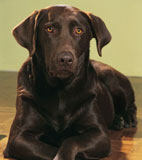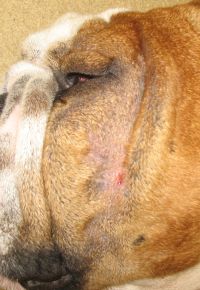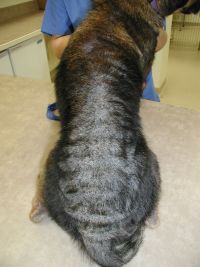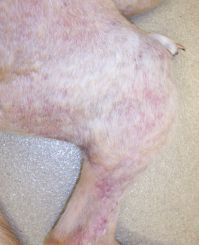How Does Losing Molars Affect a Dog’s Health?
Your pooch can’t use his molars to grind her food because his jaw doesn’t move from side to side. Instead, he uses his premolars and molars — powered by his strong jaws — for chewing large pieces of food into smaller bits. If your dog looses these teeth, he could have difficulty chewing larger pieces of food, which may mean he’ll need a softer diet to ensure he’s getting proper nutrition.
Dental Health Concerns
If your dog can eat only soft foods due to molar loss, he may be at a higher risk for tooth decay, plaque buildup and periodontal disease. Without the tooth-cleansing benefits from crunchy foods, your dog’s oral health will depend on your efforts, and those of your vet, to help him keep his teeth clean.
Health Problems With American Eskimo Dog
Luxating Patella
One medical condition that occasionally affects American Eskimo dogs is patellar luxation. This applies to all of the size groups — toy, miniature and standard. Patellar luxation describes issues with the exact location of a canine’s kneecap. When dogs have luxating patellas, their kneecaps essentially spring out of the appropriate spot. Patellar luxation is prevalent in wee and big dogs alike. If you observe anything unusual in your American Eskimo’s back legs, set up a veterinarian appointment immediately, the sooner the better. You also might notice your pet making conspicuous hopping motions as he tries to move around. Orthopedic difficulties of the back legs in general are somewhat common in American Eskimo dogs, so pay attention for any signs of them.
Progressive Retinal Atrophy
Eye issues such as progressive retinal atrophy also can affect these nimble doggies. The genetic retinal ailment progresses gradually, and with time causes blindness. If a dog has progressive retinal atrophy, either his retina ceased normal growth at too early of a stage, or his photoreceptors deteriorated at an abnormally quick pace. Progressive retinal atrophy isn’t only common in the American Eskimo breed, but also in many others such as toy poodles, Australian cattle dogs, Siberian huskies and Irish setters. If you are concerned that your precious pooch might be experiencing eyesight problems, take him to the vet immediately.
Hip Dysplasia
Hip dysplasia is another orthopedic concern that American Eskimo dogs sometimes experience. Hip dysplasia, in a nutshell, is a genetic ailment that is characterized by a hip joint that simply developed in an abnormal fashion. This leads to looseness of the joint and ultimately excessive motion of the bone in the legs. Some key symptoms of hip dysplasia in pooches are rigidness, hobbling and reluctance to partake in physical exercise or walk on stairs. If you have any reason to suspect that your precious pet might be dealing with this painful issue, bring him to the vet as soon as possible.
Diabetes
Diabetes also sometimes affects American Eskimo dogs. If a doggie has diabetes, then his body either doesn’t make sufficient insulin or doesn’t react correctly to the hormone. Be alert to signs of diabetes in canines, such as excessive urination, hazy eyes, weight loss, throwing up, exhaustion, increased hunger, dehydration and inordinate thirst. Veterinary assistance is a must for any dog who has diabetes, so don’t wait around.
Robust Dogs in General
Despite these possible medical issues, American Eskimo dogs are, on the whole, fairly robust and tough dogs. With the right care, exercise and diet, they can live happily for anywhere between 12 and 17 years. Routine appointments with the veterinarian are a must, even if your pet seems to be in 100 percent glowing condition.
Do Warts & Moles Affect a Dog’s Health?
Wart Risks
Warts are passed from dog-to-dog when an uninfected dog comes in contact with an infected dog or catches the virus in the infected dog’s environment. Warts, or viral papillomas, usually are harmless with little to no impact on a dog’s health. If your dog has a large number of oral papillomas, eating and drinking can cause significant pain and lead to malnourishment. There are only two published cases where warts have developed into cancer, according to Veterinary Partner. Oral papillomas have an increased risk of infection due to bacteria of the mouth.
Changing Moles
Moles are caused by an uncontrollable development of cells. As with human moles, most moles on dogs are harmless. Cancerous moles often have irregular borders and occasionally bleed, but even benign moles can look suspicious. Some moles have a cauliflower appearance that resembles warts, but actually are skin carcinomas. Melanoma typically develops from an older mole, so it’s important to observe moles for changes on a regular basis.
Handling Warts
Viral papillomas cannot be transferred to humans, so it’s unnecessary to isolate the dog from your family, but do keep the dog separate from uninfected dogs. Warts are most common in young dogs with immature immune systems. The warts usually disappear without treatment as the immune system matures. If the warts resist the immune system, the warts can be removed surgically or frozen. A bacterial infection secondary to oral papillomas usually is treated with a course of antibiotics.
Managing Suspicious Moles
A vet will observe a skin lesion that is changing shape, changing colors or growing larger. The mole is removed through a biopsy and tested by the veterinarian to determine if the mole is cancerous. If cancer is diagnosed, the cancer will be typed and staged to help the veterinarian choose an appropriate path for treatment. In most cases, the cancer is removed, but if organs are involved, chemotherapy is recommended without surgery. Prolonged sun exposure increases your dog’s risk for skin cancer, so be sure there are shaded areas in your dog’s outdoor environment. Although warts turning into cancer is extremely rare, prompt treatment of warts can reduce your dog’s risk for skin cancer.
Nine Ways to Prevent Canine Cancer

Provide only pure water. Tap water can contain chemicals such as lead, arsenic, and nitrates. Holistic vets strongly advise using a good-quality water purifier to filter your tap water. If you decide to buy a water purifier, keep in mind that although initially costlier than bottled water, it is much cheaper in the long run, costing only pennies a gallon, says Dr. Pitcairn. You may also decide to use bottled or distilled water. Pure water flushes toxins from the body and contributes to the feeling of well-being, says Dr. Goldstein.
Avoid contaminated water. Keep your pet away from street puddles, which can contain cancer-causing toxins such as hydrocarbons and asbestos dust from brakes.
If your pet already has cancer, avoid all vaccinations. Vaccinations can stress your pet’s immune system. For cancer patients, at the very least, avoid vaccinations during treatment because they may counteract any positive and immune-enhancing effects of your home-support program, says Dr. Goldstein. Ask your vet about the homeopathic remedy Thuja occidentalis 30C, which may remove the immune-suppressing effects of vaccinations.
Avoid indoor pollution. Keep your pet away from cigarette smoke. Studies show that secondhand smoke contains hundreds of toxic chemicals that can cause lung cancer in humans. Research also shows a strong correlation between secondhand smoke and oral cancer (squamous cell carcinoma) in cats. In dogs it’s associated with nasal sinus cancer, and even lymphoma, although the connection is weaker. The more people who smoke around a pet, the more at risk the animal is.
Ventilate your house well to reduce indoor air pollution. Grow houseplants that filter the air, such as philodendrons, spider plants, aloe vera, chrysanthemums, and gerbera daisies, but keep the plants out of your pets’ reach. Don’t use harsh chemicals such as pesticides and household cleaners around the house. Seek out natural products, such as vinegar and baking soda.
Keep your dog’s weight under control. Obese dogs are prone not only to cancer but heart ailments, joint problems, diabetes, breathing difficulties, and more. Ask your vet what a healthy weight for your dog should be and strive to achieve it. Feed your dog a healthy diet free from artificial preservatives, artificial flavors, and dyes. A healthy, balanced diet supports your dog’s natural defenses against cancer.
Use natural flea products on your dog.Did you know that flea collars, sprays, and shampoos are full of poisons? Instead of chemical insecticides, use natural and less-toxic methods of flea control such as natural flea shampoos, vacuuming frequently, and combing your pet with a flea comb. Pyrethrins are a natural and safe means of flea control, but need to be applied frequently. D-limonen and other citrus-based methods can be used in dogs, however, avoid D-limonen in cats, as it is toxic to them. Putting borates, salt, or diatomaceous earth into carpet or cracks between the wall and floor is effective for indoor flea control.
Do not allow your pet to ride in the back of a pickup truck.Along with the danger of being thrown out of the truck, your pet will be susceptible to inhaling toxic car fumes and smog. Let your dog get fresh air either by way of a park, beach, or your backyard.
Keep your dog away from pesticides and herbicides on lawns and plants.A report by the National Cancer Institute found that dogs whose owners used weed-killing products containing 2,4-D (2,4-Dichlorophenoxyzcetic Acid) had twice the rate of lymphoma as dogs whose owners did not use it. Cocoa mulch is also dangerous to dogs.
Stay clear of house and garden pesticides. Get rid of pesky insects naturally or seek out the least-toxic products. There are also nontoxic, organic products available.
Keep your pet stress-free.Stress is emotional imbalance caused by anger, frustration, or anxiety. These emotions overwork the liver, where they can stagnate and create tumors, according to Dr. Schwartz.
High anxiety in pets happens for a variety of reasons: neglect, a multiple animal household, an owner going away on vacation, or an owner going through a divorce. Whatever triggers stress in your dog, tune in and help your pet chill out.
Try some de-stressing methods such as: maintaining a regular pet routine (including feeding times and playtimes); massaging your pet; being in tune to your pet’s needs; looking for stress signals (from appetite changes to excessive barking); keeping peace in a multipet household; and providing tender loving care.
Exercise your dog on a regular basis.Research shows that canine fitness not only strengthens immunity to chronic disease such as cancer, but is also essential for optimal health and well-being.
Sustained, vigorous use of the muscles stimulates all tissues and increases blood circulation. Blood vessels dilate and blood pressure rises. As a result, tissues become oxygenated, which helps to clean the cells of toxins. Digestive glands secrete their fluids better, and the bowels move more easily, says Dr. Pitcairn.
Information on Dental Care for Dogs

Other preventive measures include providing dogs with toys and treats that have a tartar-removing effect. These include hard rubber chew toys with hollow interiors that can be stuffed with treats, as well as rope or sheepskin toys, which have fibers that help keep teeth clean.
Periodontal Disease
If a dogs teeth aren’t cared for, the result is sure to be periodontal disease, the most common dental condition affecting dogs. Periodontal disease is the inflammation and infection of the gums and supporting tissues of the teeth. It begins when bacteria-laden plaque and tartar (calculus) build up on teeth, especially below the gum line. Pockets form under the gum line and food lodges in the pockets. These bits of food that remain on teeth are breeding grounds for bacteria. The resulting infection causes bad breath, bleeding and inflammation of the gums, receding gums, loosening of teeth, and eventual tooth loss.
According to the American Veterinary Dental Society, more than 80 percent of dogs over the age of three years develop gum or periodontal disease. Any dog can develop periodontal disease, but its seen most commonly in toy breeds. They have the same number of teeth (42) as larger dogs, but the teeth are crowded into a smaller area. Regular brushing is the best way to get rid of food residue so it doesn’t harden and form the ugly brown deposits known as tartar.
Routine periodontal treatment performed by a veterinarian typically includes ultrasonic scaling, subgingival manual scaling, and polishing. For advanced cases of periodontal disease, some dental specialists use antibiotic therapy, which involves cleaning and polishing the teeth, regular home brushing, and administering antibiotics for the first five days of every month. This regimen decreases the progression of the disease. Another new treatment is Doxyrobe, a gel placed inside the socket to sterilize it. This sustained-release form of doxycycline is used in periodontal pockets to increase attachment. If the dogs teeth are in really bad shape, periodontal surgery such as bone grafting and guided tissue regeneration can be performed. For the most severe cases, extraction is the only option.
Endodontic Conditions
These conditions involve broken or abscessed teeth that require root canals or extractions. Endodontic problems are most common in large dogs, especially shepherd and retriever breeds. These dogs chew a lot on such things as fences, cow hooves, and bones, wearing their teeth down and sometimes breaking them. Even chewing on ice cubes can cause teeth to fracture.
Dental fractures are common in dogs, and treatment is a must if the pulp, the soft tissue that fills the center of a tooth, is exposed. This is not only painful, but it can also lead to tissue death and abscess. A root canal is the preferred method of treatment for such cases, although occasionally extraction may be the best choice.
Don’t ignore a broken tooth, even if it doesn’t seem to bother the dog. The majority of dogs are happier and more active once a tooth repair is made.
Oral Surgery
Oral surgery is done usually to remove teeth or repair fractured jaws. Extractions are performed with minimal pain and discomfort, and jaw fractures can be repaired using new techniques that minimize damage to teeth and ensure a rapid return to normal function.
Dogs may also need oral surgery when they’re diagnosed with tumors of the mouth and throat, which are common in dogs. Radiotherapy and recently developed surgical techniques for removing oral tumors are now available. These techniques often give excellent results, both in terms of cosmetic appearance and prognosis, provided they are applied at an early stage of the disease.
Examine your dogs mouth monthly. Oral tumors can go unnoticed until they’ve reached an advanced stage of development, making successful treatment more difficult. Bring any suspicious swellings or persistent sores to the attention of your veterinarian. Besides oral tumors, dogs can also develop noncancerous masses and swellings such as gingival hyperplasia.
Dog Skin Conditions: Allergies

Atopy Flea allergy dermatitis

Photos courtesy David A. Senter, DVM
Cause: Inhaled substances such as dust mites and pollens (atopy or allergic inhalant dermatitis, an inherited condition); flea saliva (flea allergy dermatitis); contact with or ingestion of a triggering substance, including food ingredients.
Symptoms: Itching (often severe); skin rashes ranging from slight reddening to generalized inflammation with assorted bumps, pimples, and welt-like lesions; persistent ear infections. Secondary infections by bacteria and yeasts are common.
Treatment: Allergen avoidance, flea control, antihistamines, corticosteroids (“cortisone”), cyclosporine, and hyposensitization (“allergy shots”). Antibiotics and anti-yeast medications are used to treat secondary infections. Often a combination of therapies produces the best results.
Disclaimer: DogChannel.com’s Dog Skin Conditions are intended for educational purposes only. They are not meant to replace the expertise and experience of a professional veterinarian. Do not use the information presented here to make decisions about your dog’s ailment. If you notice changes in your dog’s health or behavior, please take your pet to the nearest veterinarian or an emergency pet clinic as soon as possible.
Dog Skin Conditions: Superficial Bacterial Folliculitis

Photo courtesy David A. Senter, DVM
Cause: Most commonly, Staphylococcus (“staph”) bacteria, usually secondary to other skin disorders such as allergies, demodicosis (mange), endocrine problems, trauma, foreign bodies, and many others.
Symptoms: Shorthaired dogs often have patchy hair loss, tufts of hair raised above the coat surface and/or reddish or brown “staining” of white hairs. Longhaired dogs may have more subtle symptoms, including scaly skin, dull coat, and excessive shedding. Regardless of coat type, clipping may be necessary to fully reveal the extent of the disorder. The underlying skin lesions include bumps, pimples, crusts, or scales occurring singly, in clusters, or over large areas; reddened circular hairless areas with or without darker pigmentation in the center; scaly or crusty skin may surround the individual lesions in a circular pattern (epidermal collarettes). The degree of itchiness varies from intense to non-existent.
Treatment: Oral antibiotics for three to four weeks or longer, depending on the response; antibacterial shampoos; antibacterial ointments or sprays. Because superficial bacterial folliculitis occurs secondary to other disorders, identification and concurrent treatment of the underlying cause are essential for successful resolution.
Disclaimer: DogChannel.com’s Dog Skin Conditions are intended for educational purposes only. They are not meant to replace the expertise and experience of a professional veterinarian. Do not use the information presented here to make decisions about your dog’s ailment. If you notice changes in your dog’s health or behavior, please take your pet to the nearest veterinarian or an emergency pet clinic as soon as possible.





